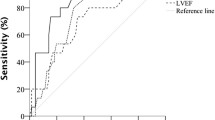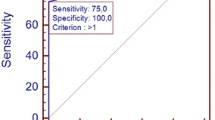Abstract
Aims
The purpose of this study was to evaluate whether CMRI provides characteristic findings in patients with acute chest pain suffering from ST-elevation-myocardial infarction (STEMI), non-ST-elevation myocardial infarction (NSTEMI), acute myocarditis or Tako-tsubo cardiomyopathy.
Patients and methods
230 consecutive patients with acute chest pain underwent cardiac catheterization followed by CMRI within median 5 days. Patients were classified to suffer from STEMI (n = 102), NSTEMI (n = 89), acute myocarditis (n = 27), or Tako-tsubo cardiomyopathy (n = 12) on the synopsis of all clinical data. Wall motion abnormalities, late enhancement (LE), persistent microvascular obstruction as well ventricular volumes and functions were assessed by CMRI.
Results
Right and left ventricular volumes were significantly different between the groups and values were highest in patients with acute myocarditis. Wall motion abnormalities were observed in 100% of STEMI, 75% of NSTEMI, 67% of acute myocarditis and 100% of Tako-tsubo patients. There was a characteristic pattern of abnormal wall motion focused on midventricular-apical segments in patients with Tako-tsubo cardiomyopathy, depending on the culprit vessel in patients with STEMI/NSTEMI and with a random distribution in patients with acute myocarditis. LE was mainly subendocardial or transmural in patients with STEMI (93.2%) or NSTEMI (62.9%). LE was diffuse, intramural or subepicardial in patients with acute myocarditis. No LE was observed in patients with Tako-tsubo cardiomyopathy. Persistent microvascular obstruction was only visualized in patients with STEMI (33%) or NSTEMI (6%).
Conclusions
Cardiac magnetic resonance imaging provides characteristic patterns of LE, persistent microvascular obstruction and wall motion abnormalities that allow a differentiation between patients with acute chest pain from coronary and non-coronary origin.



Similar content being viewed by others
References
Appelbaum E, Kirtane AJ, Clark A, Pride YB, Gelfand EV, Harrigan CJ, Kissinger KV, Manning WJ, Gibson CM (2008) Association of TIMI myocardial perfusion grade and ST-segment resolution with cardiovascular magnetic resonance measures of microvascular obstruction and infarct size following ST-segment elevation myocardial infarction. J Thromb Thrombolysis, Epub ahead of print
Athanasiadis A, Vogelsberg H, Hauer B, Meinhardt G, Hill S, Sechtem U (2006) Transient left ventricular dysfunction with apical ballooning (tako-tsubo cardiomyopathy) in Germany. Clin Res Cardiol 95:321–328
Bogaert J, Kalantzi M, Rademakers FE, Dymarkowski S, Janssens S (2007) Determinants and impact of microvascular obstruction in successfully reperfused ST-segment elevation myocardial infarction. Assessment by magnetic resonance imaging. Eur Radiol 17:2572–2580
Bruder O, Breuckmann F, Jensen C, Jochims M, Naber CK, Barkhausen J, Erbel R, Sabin GV (2008) Prognostic impact of contrast-enhanced CMR early after acute ST segment elevation myocardial infarction (STEMI) in a regional STEMI network: results of the “Herzinfarktverbund Essen”. Herz 33:136–142
Cerqueira MD, Weissman NJ, Dilsizian V, Jacobs AK, Kaul S, Laskey WK, Pennell DJ, Rumberger JA, Ryan T, Verani MS (2002) American Heart Association writing group on myocardial segmentation and registration for cardiac imaging. standardized myocardial segmentation and nomenclature for tomographic imaging of the heart: a statement for healthcare professionals from the Cardiac Imaging Committee of the Council on Clinical Cardiology of the American Heart Association. Circulation 105:539–542
Christiansen JP, Edwards C, Sinclair T, Armstrong G, Scott A, Patel H, Hart H (2006) Detection of myocardial scar by contrast-enhanced cardiac magnetic resonance imaging in patients with troponin-positive chest pain and minimal angiographic coronary artery disease. Am J Cardiol 97:768–771
Deetjen AG, Conradi G, Mollmann S, Rad A, Hamm CW, Dill T (2006) Value of gadolinium-enhanced magnetic resonance imaging in patients with Tako-Tsubo-like left ventricular dysfunction. J Cardiovasc Magn Reson 8:367–372
Friedrich MG, Strohm O, Schulz-Menger J, Marciniak H, Luft FC, Dietz R (1998) Contrast media–enhanced magnetic resonance imaging visualizes myocardial changes in the course of viral myocarditis. Circulation 97:1802–1809
Haghi D, Fluechter S, Suselbeck T, Borggrefe M, Papavassiliu T (2005) Delayed hyperenhancement in a case of Takotsubo cardiomyopathy. J Cardiovasc Magn Reson 7:845–847
Hombach V, Grebe O, Merkle N, Waldenmaier S, Hoher M, Kochs M, Wohrle J, Kestler HA (2005) Sequelae of acute myocardial infarction regarding cardiac structure and function and their prognostic significance as assessed by magnetic resonance imaging. Eur Heart J 26:549–557
Hunold P, Schlosser T, Vogt FM, Eggebrecht H, Schmermund A, Bruder O, Schuler WO, Barkhausen J (2005) Myocardial late enhancement in contrast-enhanced cardiac MRI: distinction between infarction scar and non-infarction-related disease. AJR Am J Roentgenol 184:1420–1426
Jesel L, Morel O, Ohlmann P, Germain P, Faure A, Jahn C, Coulbois PM, Chauvin M, Bareiss P, Roul G (2007) Role of pre-infarction angina and inflammatory status in the extent of microvascular obstruction detected by MRI in myocardial infarction patients treated by PCI. Int J Cardiol 121:139–147
Kwong RY, Chan AK, Brown KA, Chan CW, Reynolds HG, Tsang S, Davis RB (2006) Impact of unrecognized myocardial scar detected by cardiac magnetic resonance imaging on event-free survival in patients presenting with signs or symptoms of coronary artery disease. Circulation 113:2733–2743
Kwong RY, Schussheim AE, Rekhraj S, Aletras AH, Geller N, Davis J, Christian TF, Balaban RS, Arai AE (2003) Detecting acute coronary syndrome in the emergency department with cardiac magnetic resonance imaging. Circulation 107:531–537
Look D, Locker D (1970) Time saving measurement of NMR and EPR relaxation times. Rev Sci Instrum 41:250–251
Mahrholdt H, Goedecke C, Wagner A, Meinhardt G, Athanasiadis A, Vogelsberg H, Fritz P, Klingel K, Kandolf R, Sechtem U (2004) Cardiovascular magnetic resonance assessment of human myocarditis: a comparison to histology and molecular pathology. Circulation 109:1250–1258
Mahrholdt H, Wagner A, Judd RM, Sechtem U (2002) Assessment of myocardial viability by cardiovascular magnetic resonance imaging. Eur Heart J 23:602–619
Nef HM, Möllmann H, Elsässer A (2007) Tako-tsubo cardiomyopathy (apical ballooning). Heart 93:1309–1315
Nef HM, Möllmann H, Kostin S, Troidl C, Voss S, Weber M, Dill T, Rolf A, Brandt R, Hamm CW, Elsässer A (2007) Tako-Tsubo cardiomyopathy: intraindividual structural analysis in the acute phase and after functional recovery. Eur Heart J 28:2456–2464
Nijveldt R, Beek AM, Hofman MB, Umans VA, Algra PR, Spreeuwenberg MD, Visser CA, van Rossum AC (2007) Late gadolinium-enhanced cardiovascular magnetic resonance evaluation of infarct size and microvascular obstruction in optimally treated patients after acute myocardial infarction. J Cardiovasc Magn Reson 9:765–770
Pope JH, Aufderheide TP, Ruthazer R, Woolard RH, Feldman JA, Beshansky JR, Griffith JL, Selker HP (2000) Missed diagnoses of acute cardiac ischemia in the emergency department. N Engl J Med 342:1163–1170
Pruessmann KP, Weiger M, Scheidegger MB, Boesiger P (1999) SENSE: sensitivity encoding for fast MRI. Magn Reson Med 42:952–962
Vogel-Claussen J, Rochitte CE, Wu KC, Kamel IR, Foo TK, Lima JA, Bluemke DA (2006) Delayed enhancement MR imaging: utility in myocardial assessment. Radiographics 26:795–810
Wohrle J, Krause BJ, Nusser T, Mottaghy FM, Habig T, Kochs M, Kotzerke J, Reske SN, Hombach V, Hoher M (2006) Intracoronary beta-brachytherapy using a rhenium-188 filled balloon catheter in restenotic lesions of native coronary arteries and venous bypass grafts. Eur J Nucl Med Mol Imaging 33:1314–1320
Zimmermann O, Grebe O, Merkle N, Nusser T, Kochs M, Bienek-Ziolkowski M, Hombach V, Torzewski J (2006) Myocardial biopsy findings and gadolinium enhanced cardiovascular magnetic resonance in dilated cardiomyopathy. Eur J Heart Fail 8:162–166
Author information
Authors and Affiliations
Corresponding author
Additional information
Supported in part by an unrestricted grant of Philips Medical Systems Best, The Netherlands, and Hamburg, Germany.
For paper handling: jochen.woehrle@uniklinik-ulm.de
Rights and permissions
About this article
Cite this article
Hombach, V., Merkle, N., Kestler, H.A. et al. Characterization of patients with acute chest pain using cardiac magnetic resonance imaging. Clin Res Cardiol 97, 760–767 (2008). https://doi.org/10.1007/s00392-008-0675-4
Received:
Accepted:
Published:
Issue Date:
DOI: https://doi.org/10.1007/s00392-008-0675-4




